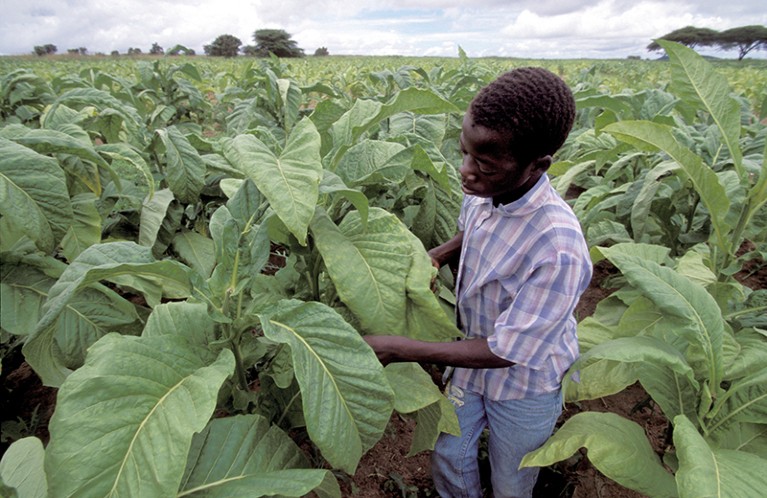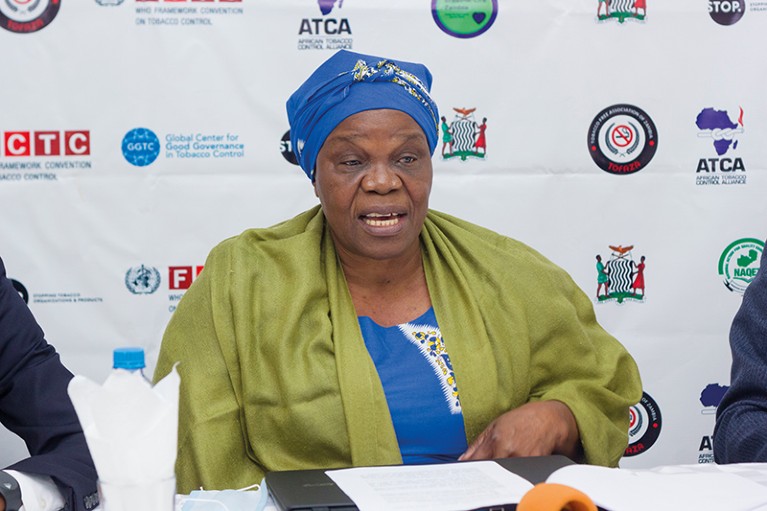Fastone Goma, a physician and chair of the Zambia Non-Communicable Disease Alliance, has been working for more than 15 years to pass tobacco cessation legislation in Zambia. Bills have gone to several ministers of health, agriculture and commerce, trade and industry for their consideration. But they have never made it to the National Assembly for a vote.
Given the forces that hold sway over the country’s economic policies, that outcome is not terribly surprising. “Zambia is one of the major tobacco producers in the sub-Saharan Africa region, so when we talk about tobacco control, it has to be balanced with the commercial interests of farmers and growers,” says Goma. “It ends up in an endless cycle, all aimed at them not losing money from the sale of tobacco.”
Goma is one of a group of individuals and organizations that have been working to combat the messages of the tobacco industry, educating lawmakers on how cigarettes and related products harm the nation’s health and economy. He hopes that the Tobacco and Nicotine Products Control Bill, a draft of which was finalized in 2018, will succeed where others have failed. The country’s current minister of health, Sylvia Masebo, has been supportive and has an encouraging record.
It is easy to see why anti-smoking legislation might not always have been a priority for African countries. Currently, the continent has the lowest rates of smoking in the world: in 2020, only about 10.3% of the population smoked according to the World Health Organization (WHO)1. Worldwide, smoking prevalence stands at 22.3%. But in the past decade, researchers and activists have begun raising red flags. Africa’s improving economy and young, fast-growing population could drive a surge in smoking. The confluence of trends has not gone unnoticed by the tobacco industry, which focuses intense attention on the region and on governments that have been slow to introduce anti-smoking regulations. All of this, says Goma, could add up to an epidemic in the coming years.
Growth opportunity
Nowhere else has the number of smokers increased more since 1990 than in Africa — 104% in North Africa and the Middle East and almost 75% in sub-Saharan Africa2. There were about 66 million smokers on the continent in 2015; by 2025, it’s estimated there could be 84 million3. It is one of only two parts of the world, along with the eastern Mediterranean region, where tobacco smoking is set to grow in the coming decade.
“Africa is in its nascent stages of development,” says Peter Magati, an independent economist and tobacco researcher based in Kenya. He sees the region as “playing catch-up” to Europe and North America, and likely to encounter problems similar to those that development brought in those areas. “They have already been through this and we are following the same cycle, being perceived as a new market for tobacco companies,” he says.
Africa’s young people are a particular target. A 2022 analysis led by researchers at the University of Sierra Leone found that an average of 19% of adolescents aged from 11 to 17 in 22 African countries reported using tobacco products4. Zimbabwe ranked the highest at 47%. Rates of young men using tobacco were higher than those of women, at 24% and 14% respectively. This is similar to the split seen in Africa’s adult population more generally.
“We are still on an upward trajectory in most of the countries in Africa,” Goma says. He pins the most responsibility on tobacco companies, which he contends “are really targeting teens”. As a result, he predicts, “in a few years’ time we are going to see those increased rates among African adults”.
Actions not taken
The researchers at the University of Sierra Leone found that breathing second-hand smoke was strongly associated with adolescent tobacco use. But there were several other factors that increased risk, including exposure to tobacco industry promotions and a lack of education about tobacco’s health effects.
Some of these factors could be addressed by implementing recommendations from the WHO Framework Convention on Tobacco Control (FCTC). The FCTC was adopted by the World Health Assembly in 2003 to stymie tobacco use globally through regulatory strategies. The main components include monitoring tobacco use, banning tobacco use in public spaces, providing cessation services to people who want to quit, placing graphic warning labels on tobacco products, banning tobacco companies from advertising and sponsorships and raising taxes on tobacco products.

So far, 43 of the 46 countries in sub-Saharan Africa have signed the FCTC. “Countries in Africa wanted to step forward,” says Anna Gilmore, a public-health researcher at the University of Bath, UK. “They can’t afford to pay for the health-care costs and damage [of smoking],” adds Gilmore, who is a member of Stopping Tobacco Organizations and Products (STOP), a global tobacco industry watchdog. “They were incredibly positive and helped drive through a strong treaty.”
But despite their engagement in creating the FCTC, African countries have typically lagged behind when it comes to enacting its policies. Pictorial warnings on cigarette packages, smoking bans in restaurants and bars, and bans on displaying products in retail — policies that many high-income countries have followed for decades — have been adopted by only around one-third of countries in sub-Saharan Africa3.
Industry pressure
The main reason that African countries haven’t implemented more FCTC recommendations, according to researchers and activists, is the influence of the tobacco industry.
“I think of it in terms of power imbalances,” Gilmore says. In countries with small gross domestic products (GDPs), she says, wealthy industries can interfere and influence in ways that they might not be able to in richer nations. “These companies are more outrageous in what they will do in low- and middle-income countries,” she says.
A 2021 report5 by the African Tobacco Control Alliance ranked 14 countries in sub-Saharan Africa according to how much influence the industry wielded over them, how transparent governments made their dealings with tobacco companies and what measures were in place to rebuff their advances. Zambia was found to have the highest level of interference, followed by Tanzania, South Africa and Mozambique.
In 2018, comprehensive tobacco legislation was announced in South Africa that included FCTC provisions such as requiring plain packaging on cigarettes, banning the display of tobacco products in retail and regulating e-cigarettes. The bill has yet to pass and, according to research by Gilmore and colleagues, industry efforts could be partially to blame.
For example, cigarette producer Japan Tobacco International responded by launching a campaign called #HandsOffMyChoices arguing against numerous aspects of the proposed bill, and conducted a survey that suggested there was little support for plain packaging among people in South Africa. And the Tobacco Institute of Southern Africa, an industry association, began a ‘#TakeBackTheTax’ campaign that reflects industry arguments regarding the value of tobacco taxation and employment.
There are also accusations that the tobacco industry attempts to influence policies by making payments to individuals. In 2021, Gilmore’s research group published an analysis of documents provided by two whistle-blowers at the cigarette company British American Tobacco (BAT), one of the main players in Africa. The report claims that, between 2008 and 2013, BAT made payments totalling US$601,502 to individuals in the form of cash, wire transfers, campaign donations and expensive gifts6. The recipients included politicians and civil servants in Burundi, Comoros, Rwanda and Uganda, at a time when tobacco control legislation was being considered in all four countries. Uganda finally passed comprehensive tobacco legislation in 2015; regulation in the other three countries still falls short of FCTC guidelines.
Influence can also be subtler. Tobacco companies provide funding for public-policy think tanks, such as the IMANI Center for Policy & Education in Ghana, which has publicly opposed tobacco control and even the link between smoking and lung cancer. Furthermore, and against FCTC recommendations, tobacco companies in Africa often participate in corporate social responsibility programmes, such as providing scholarships to low-income students, or donating to COVID-19 relief funds. “In the United States and United Kingdom, the industry has been denormalized,” Gilmore says. “But in Africa, the tobacco industry is still seen as acceptable and puts loads of money into maintaining that image.”
Nature reached out to tobacco companies including Philip Morris International, Roland Imperial Tobacco Company and BAT for comment. Only BAT responded to questions regarding the industry’s influence on FCTC uptake in Africa through e-mail: “We support many of the objectives of the World Health Organization’s Framework Convention on Tobacco Control. This includes measures to reduce underage smoking, reinforcing the already well-established public awareness of the health risks of smoking, encouraging smoking cessation, and eliminating illicit trade in tobacco products. We believe regulation should be based on sound evidence and wide consultation, respect legal rights, and be aimed at delivering harm reduction.”
A taxing problem
One of the most effective tools to reduce tobacco use is raising the price of these products by imposing higher taxes on them. According to the WHO, increasing prices by 10% can reduce smoking rates by 5% in low- and middle-income countries7. The FCTC recommended tax rate is 75%; globally, the median tax rate is 60%. But in Africa, the median tax rate is just 34% — the lowest in the world8.
Tobacco companies consistently fight tax increases. In South Africa, for example, industry-backed groups lobbied successfully in 2020 to keep taxes on cigarettes unchanged, at 40%. The typical arguments of these groups are that increasing taxes on tobacco products will reduce legitimate sales and increase illicit trade, with the net effect of decreasing governments’ revenue — and thus putting numerous tobacco-related farming and manufacturing jobs at risk.
“Their pet arguments are about revenue,” says Jeff Drope, a health-policy researcher at University of Illinois Chicago’s School of Public Health. He thinks that concerns that revenue will fall if taxes go up are misplaced. “Consumption goes down, but revenue goes up because people are paying more taxes,” he says. In the mid-1990s the South African government decided to increase cigarette taxes to 50% of the retail price. By 2004, this tax had increased by 256% per pack, and smoking prevalence dropped from 32% to 24%. At the same time, government revenue increased 140%9.
The risk of lost jobs might also be overstated by the industry. “Tobacco doesn’t employ a lot of people,” Drope says. In Zambia, more than two-thirds of the population relies on agriculture for their income, but only a fraction are growing tobacco. According to a 2017 report co-authored by Goma and Drope, cotton, tea, coffee and maize (corn) are the largest export-oriented agricultural commodities in Zambia, accounting for US$589 million in 2012, or 2.31% of the nation’s GDP10. Tobacco, by contrast, accounted for just 0.4% of Zambia’s GDP. Tobacco was being grown on 59,000 hectares by around 10,000 farmers; the other 4 crops were grown on about 1.5 million hectares by more than 1.2 million farmers. Cigarette-manufacturing facilities opened in Zambia in 2018 and 2019, by BAT and Roland Imperial Tobacco Company respectively, reportedly created fewer than 200 jobs for local workers.

Brenda Chitindi, executive director of the Tobacco Free Association of Zambia, says that the industry exaggerates the number of people employed in it by including family members of employees as workers in ‘tobacco-farming households’. Some African farmers are also known to use children to reduce their labour costs, she says.
Drope also thinks that any job losses that do occur will be balanced by the creation of jobs in other sectors. “When people decrease spending on tobacco, they start spending more on health care and education, which are labour-intensive sectors,” he says. “Often, there is a net gain in employment.”
Tobacconomics, a tobacco-control think tank at the University of Illinois Chicago that counts Drope among its researchers, studied the potential results of tax increases in several low- and middle-income countries, including North Macedonia, Pakistan, Mexico, Argentina and Indonesia. The group found that these countries would end up with at least a small net employment gain if tobacco sales dropped because people would spend more on food, education and health, leading to job growth in these sectors (see go.nature.com/3yv2cuv).
Enforcement challenges
Despite industry pressure, some countries have passed legislation on the basis of FCTC recommendations. In 2007, for example, Kenya passed the comprehensive Tobacco Control Act — an action that Magati attributes to a constitution that allows citizens to propose legislation. In many other African countries, it must come from government officials. “Power here doesn’t rest with a few individuals,” he says. “The tobacco industry isn’t able to influence here as it can in other places.”
In 2014, Senegal also introduced comprehensive legislation and began requiring graphic health warnings on cigarette packages in 2017. By 2018, the government had raised tobacco taxes to 65%.
However, legislating is only part of the battle. Despite its intentions, Senegal has struggled to implement its plans for smoke-free spaces and warning labels. It is not alone in this: in many African countries, even when laws are put in place, local authorities lack the will, personnel and money to enforce them. “Governments are struggling with budgets and looking at immediate concerns like poverty and hunger, so enforcement agents have limited resources to function even when they are committed,” Magati says.
There aren’t a lot of data on how much African countries spend on tobacco control, but one estimate puts it at about $0.006 per capita3. Staving off the rapid growth of smoking that many fear Africa could experience will therefore take more than just a willing, educated government — it will also require advocacy from civil society and external funding.
Sierra Leone passed the Tobacco and Nicotine Control Act of 2022 last August. The bill came to be in part because of investments by the WHO in developing the law and providing data to illustrate the impact it would have on the country’s health. Drope, meanwhile, is advising 22 countries on tobacco taxation. He works with local universities and think tanks to provide education on smoking and thinks these kinds of collaboration are crucial to helping the continent kick the habit. “When we are all singing from the same song sheet, it really helps,” he says. “It takes folks getting bombarded with the same message from a lot of different messengers.”
In Zambia, laws that prohibit smoking in public places are routinely ignored, Goma says, as is a ban on sales to people aged 16 and younger. In fact, he frequently sees young children selling individual cigarettes. Advertising restrictions are also not adhered to. “They put displays targeting children near the sweets and other children’s foods,” Chitindi says.
“Because rates of tobacco use are still low, everyone thinks it’s not a problem,” Goma says. This is misguided, he says. “The future is what we must be worried about because we are on an upward trajectory. If we don’t control smoking rates among the young now, we are bound to have a big problem on our hands.”
Source : Nature











